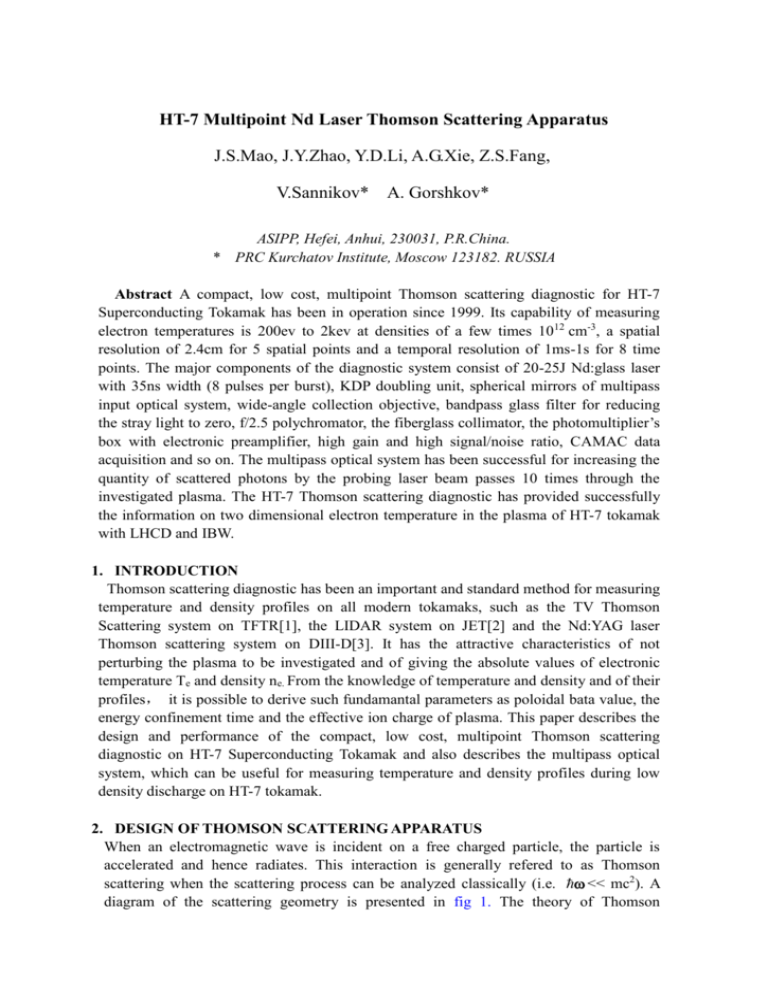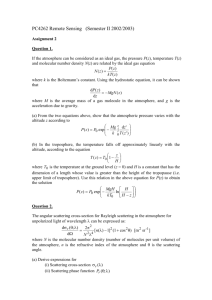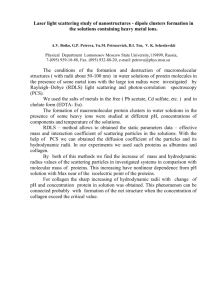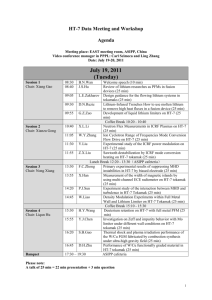Multipoint Nd Laser Thomson Scattering Diagnostic
advertisement

HT-7 Multipoint Nd Laser Thomson Scattering Apparatus J.S.Mao, J.Y.Zhao, Y.D.Li, A.G.Xie, Z.S.Fang, V.Sannikov* A. Gorshkov* * ASIPP, Hefei, Anhui, 230031, P.R.China. PRC Kurchatov Institute, Moscow 123182. RUSSIA Abstract A compact, low cost, multipoint Thomson scattering diagnostic for HT-7 Superconducting Tokamak has been in operation since 1999. Its capability of measuring electron temperatures is 200ev to 2kev at densities of a few times 1012 cm-3, a spatial resolution of 2.4cm for 5 spatial points and a temporal resolution of 1ms-1s for 8 time points. The major components of the diagnostic system consist of 20-25J Nd:glass laser with 35ns width (8 pulses per burst), KDP doubling unit, spherical mirrors of multipass input optical system, wide-angle collection objective, bandpass glass filter for reducing the stray light to zero, f/2.5 polychromator, the fiberglass collimator, the photomultiplier’s box with electronic preamplifier, high gain and high signal/noise ratio, CAMAC data acquisition and so on. The multipass optical system has been successful for increasing the quantity of scattered photons by the probing laser beam passes 10 times through the investigated plasma. The HT-7 Thomson scattering diagnostic has provided successfully the information on two dimensional electron temperature in the plasma of HT-7 tokamak with LHCD and IBW. 1. INTRODUCTION Thomson scattering diagnostic has been an important and standard method for measuring temperature and density profiles on all modern tokamaks, such as the TV Thomson Scattering system on TFTR[1], the LIDAR system on JET[2] and the Nd:YAG laser Thomson scattering system on DIII-D[3]. It has the attractive characteristics of not perturbing the plasma to be investigated and of giving the absolute values of electronic temperature Te and density ne. From the knowledge of temperature and density and of their profiles, it is possible to derive such fundamantal parameters as poloidal bata value, the energy confinement time and the effective ion charge of plasma. This paper describes the design and performance of the compact, low cost, multipoint Thomson scattering diagnostic on HT-7 Superconducting Tokamak and also describes the multipass optical system, which can be useful for measuring temperature and density profiles during low density discharge on HT-7 tokamak. 2. DESIGN OF THOMSON SCATTERING APPARATUS When an electromagnetic wave is incident on a free charged particle, the particle is accelerated and hence radiates. This interaction is generally refered to as Thomson scattering when the scattering process can be analyzed classically (i.e. << mc2). A diagram of the scattering geometry is presented in fig 1. The theory of Thomson scattering from a collection of free electrons is well developed[1,2]. The time-averaged radiated power per unit solid angle is dPs c q2 ( )( 2 ) 2 E 02 [n (n )] 2 d 8 mc where (1) Ps = scattering power = speed of light in vacuum c = time average E0 = the plane electromagnetic wave with electric field Because the radiated power depends inversely on the mass of the charged particle the radiation of the ions is negligible compared to the radiation of the electrons. In a plasma, collective behavior only arrises over distances greater than the Debeye length, D , inconherent scattering occurs for in D . In HT-7 Thomson scattering experiment discussed in in / D .01 , so that only the theory of incoherent scattering need be considered. The frequency spectrum of the scattered power for a plasma has been calculated by several authors[2,3]. The scattering intensity is shown to be propotional to the dynamic form factor S(k, ). S(k, ) 1 ( 2 ) 2 dtn k ( t ) exp( it ) 2 n k dr[ (r r j ( t )) n ] exp( jk r ) v rj = location of the jth electron n = mean density < >= statistical average over an ensemble of systems Physically, the observed frequency spectrum is du to a double Doppler shift of the incident electromagnetic wave. The first shift is caused by the motion of the electrons relation to the incident radiation and the second shift is due to the motion of the radiating electrons relative to the observer. Fig. 2 shows the scattered power spectrum for various electron temperatures. For a plasma in thermodynamic equilibrium the frequency spectrum of the scattered power is given by where S ( ) 1 1 C me 2 1 1 2 4 2k T e 2 ) sin ( 0 2 me exp[ 8 02 sin 2 I( s )d ne . I0 . T ..S()d 2 2 ] (2) kTe (3) where 0 = incident wavelength s = observed wavelenth s i = scattering angle (see fig.1), =900 in HT-7 Thomson scattering system ne = electron density I0 = incident laser power T = differential scattering cross section = length of scattering volume C = speed of light in vacuum = observed solid angle 2 The differential scattering cross section is defined as q2 2 d T [n (n )] 2 d mc This is a very small quantity and for most Thomson scattering experiments only one out of every 1013 incident photons is scattering by the plasma electrons. For electron temperature up to 1 keV, the relativistic effects can be neglected, but when temperature of electron is higher it must be taken into account using the formula for thetheoretical spectrum[4.5] 2 2 B exp 1 3.5 S( ) 7.6 1 2 0 0 sin ( / 2)Te 0 sin( / 2) Te 0 A and B are numerical constants. The shape of the spectrum is changed due to the relativistic effect(see fig 2) When designing a Thomson scattering system, the principal problems are getting sufficient scattering signal; suppression of stray light and suppression of plasma light. Increasing the laser energy clearly helps the first of these problems. Increasing the laser power is for increase the ratio of scattering signal to plasma light. For these reasons the Q switched solid body laser has been the most commonly used light source for incoherent Thomson scattering measurements. For HT-7 tokamak the Nd:glass laser is designed. An e 3. THOMSON SCATTERING APPARATUS ON HT-7 TOKAMAK The capability measuring electron temperatures of HT-7 Thomson scattering system is 200ev to 2kev at densities of a few times 1012 cm-3, a spatial resolution of 2.4cm for 5 spatial points and a temporal resolution of 1ms-1s for 8 time points. The major components of the diagnostic system consist of 20-25J Nd:glass laser with 35ns width (8 pulses per burst), KDP doubling unit, spherical mirrors of multipass input optical system, wide-angle collection objective, bandpass glass filter for reducing the stray light to zero, f/2.5 polychromator, the fiberglass collimator, the photomultiplier’s box with electronic preamplifier, high gain and high signal/noise ratio, CAMAC data acquisition. The Nd:glass laser for HT-7 tokamak is not directly useful, because good photocathodes doesn’t yet exist in the spectral region near micron. The advantage of working at 5300Å is the sensitive for photocathodes (15%) more than at 6943 Å (ruby laser 3%). Reduction of stray light was achieved both by a complicated baffles system, by using a spectrograph with a high contrast, and especially by using a laser line rejection filter, so the stray light was suppressed completely to zero. To increase signal-to-noise ratio and reduce the contribution of plasma radiation, two Q switched was used inside laser system, to make the width of laser pulse 35ns. The multipass optical system has been successful for increasing the quantity of scattered photons by the probing laser beam passes 10 times through the investigated plasma. Layouts of HT-7 T.S. diagnostic components is shown in Fig.3. 3.1 ND-GLASS LASER SYSTEM In the HT-7 T.S. system, the solid state Nd:glass laser is used. Nd-glass laser is consist of an oscillator and an amplifier. The oscillator consists of a ring resonator and produces very stable radiation during the burst. A Dove prism with Brester’s angles on both sides is located inside the resonator( see fig.4). Due to Dove prism the cross-section of the light beam is rotated inside the resonator along the optical axis of the oscillator to reduce the thermal stress which are accumulated during the operation of the master oscillator. The Q-switch is done by an plate of LiF crystal with colored centers. Near diffraction-limited performance was achieved with a high quality a thermal phosphate Nd-glass rod (GLS-22). The oscillator is constrained to operate in a TEMoo mode and produces about 50mJ. The radiation line width is typically less than 0.01Å and pulse duration is about of 40 nsec. The oscillator is capable to work with repetition rate 1Hz and in a single shot model. The model with repetition rate 1Hz is very convenient for alignment or checking operation system. The laser light amplifier is designed with telescopic resonator with 7 passes of the beam and can operate in regimes with 1 or 8 pulses in the burst (see fig.5). This thermally stable and compact design provides the multipulse regime with high output power. A LiF-2 plate with colored is located inside the telescopic for Q switch and also for protecting the master oscillator from back-emission. The Laser pulse duration is about of 30-35 nsec. The high power levers of Nd-glass laser make him well suited for harmonic generation by passing the beam through nonlinear KDP crystal, which halves the wavelength to 5300Å and produce the 4-5 joules of green light. The increasing laser power density becomes more efficient by KDP’s nonlinear process. 3.2 PHOTODETECTOR’S SUBSYSTEM The wide-angle collection objective (F=200mm) passes the scattered light to the image fiberglass dissector. The five vertical fibers work as the input slits of the spectrometer. The five sets are used for spatial resolution, each set corresponds to an individual spatial point along the small radius of plasmacolumn. The polychromator is designed as high luminosity system in Clocktype configuration[6] having a lage value of slit’s height and f=1/2.5.( see fig. 6) Fiberglass couples the polychromater output to the photomulti-tubes. The transmission of the guides is about 0.7-0.8. The stray light of second harmonic (5300Å), which has passed through the collection optic , is reduced by bandpass glass filter. Two pieces of the filters are installed before the input fiberglass guides. The shap boundary of spectral curve (see fig.7) provides the strong decreasing of stray light (near zero) and high transmission in measured part of the scattered spectrum(> 90%). The bandpass glass filter allows to measuure the wide region of electron temperature without loss of the signals. Another special glass filter is used to cut off of fundamental laser radiation(1.06μ) before input window of the vacuum chamber. This filter has high damage resistant for high power laser. The photomultiplier tube (PMT-84) with S-20 photocathode is used for the detection of scattered light. The quantum efficiency (near λ=5300Å ) is 10%-12%. The boxes are designed to protect PMT from outside light and electromagnetic radiation. To improve the operation of PMT with very fast impulse, the last dynodes of PMT are protected by the capacities. The two stagers of amplifiers are coupled with PMT. The gain of preamplifier is about 50 and the frequency range is about 0.15-35MHz in order to suppress the radiation from plasma bremsstrahlung and macroscopic instability, which are two main sources of unwanted radiation that decrease the ratio of signal to noise. A low frequency limit is about 400KHz in order to pass low frequency signal from tungsten ribbon lamp with mechanical chopper for calibration unit. The signals from PMT are sent to analyzing electronic units though the gate in Data Acquisition system.(CAMAC 2250) 3.3 THE CALIBRATION SYSTEM In order to evaluate the measured signals quantitatively, the spectral sensitivity of 25 channels and polychromator has to be attained in a preceding calibration measurement with relatively high wavelength resolution. The light of a stabilized tungsten ribbon lamp is passed through the polychromator with appropriate resolution. (see fig.8) Each individual channel is measured as a function of wavelength. The light is chopped with the duration about 60-70μsec, which is produced by mechanical chopper-wheel. The light has to pass through the polychromator just as the Thomson scattered light. The correct calibration of the photodetectors and processing system is needed about 1000 accounts. 4. MULTIPASS OPTICAL SYSTEM Due to low value of T.S cross-section 6 10 cm , so the quantity of scattered photons are too poor( N ). In order to increase the scattered signal, it is possible to pass few times the probing beam through investigated plasma region. Multipass Optics System (MOS) is used to increase the accuracy of the T.S measurements in tokamak[7,8]. It is the first time to be used on HT-7 tokamak.(see Fig.3). The MOS is consist of two spherical mirrors, which is formed a cavity(the radius of curvature R=1.6m, the mirror diameter D=5.2cm,R>>D) and the mirrors are installed on a distance 3.2m,allowing to pass through plasma volume 10 times. 25 2 0 0 5. MEASUREMENT OF TEMPERATURE PROFILE The HT-7 is a superconducting tokamak. It was reconstructed from the original Russian T-7 tokamak in 1994. The feedback control system to simultancously control plasma current,density and displacement was developed and put into daily operation since Spring in 1998. [9.10]The HT-7 tokamak has a major radius of R=1.22m, minor radius of a=0.26-0.28m defined by a full circular limiter. The layout of HT-7 superconducting tokamak is shown in fig9. The major research fields on the HT-7 are steady-state operation, high-performance discharge, the fuelling study, LHCD and ICRF heating. After good alignment and calibration, the HT-7 Thomson scattering diagnostic has provided successfully the information on two dimensional electron temperature profiles in the plasma of HT-7 tokamak with Ohmic, LHCD and IBW heating. Fig.10 shows the electron temperature profile Te(r) during Ohmic heating (Ip~130KA,Ne~1.1, Te (0)~0.75kev-0.85kev). Fig .11 shows the electron temperature profile Te (t) by 8 peices of laser pulse. Fig 12 shows Te(0,t) during LHCD. The electron temperature of center plasma is lager than 1KeV. REFERENCES 1. M.J.Forrest ,et al Culham Plasma Physics Laboratory, Report CLM 107 (1970) 2. J. Sheffield, Plasma Scattering of Electromagnetic Radiation Academic Press, New York(1975) 3. K.W. Gentle, “TEXT User Handbook”, University of Texas, Fusion Research Center (1984) 4. B.F.M.Potz, J.J.H. Coumans and D.C. Schram, Phys. Flluids.,24(3),517,(1981) 5. S.E.Segre, Thomson scattering from a plasma in Course on Plasma Diagnostic and Data Acquisition System (Ed.A.Eubank and E.Sindoni, International School of plasma Physics, Varenna,(1975). 6. D.Johnson, N.Bretz et al , Rev. Sci. Instrum. 57, 1856(1986). 7. H. Salzmann et al., Rev. Sci. Instrum. 59,1451 (1988) 8. C.L. Hsieh, J. Haskovec et al, Sci. Instrum.61,2855(1990) 9. Xie,J.K. and the HT-7 Group, in Plasma Physics and Controlled Nuclear Fusion Reserch 1996( proc. 16th Int. Conf. Montreal, 19960, Vol.1, IAEA(1997)685. 10. Li,J., et al., Nucl. Fusion 41 (1999) 1349.









